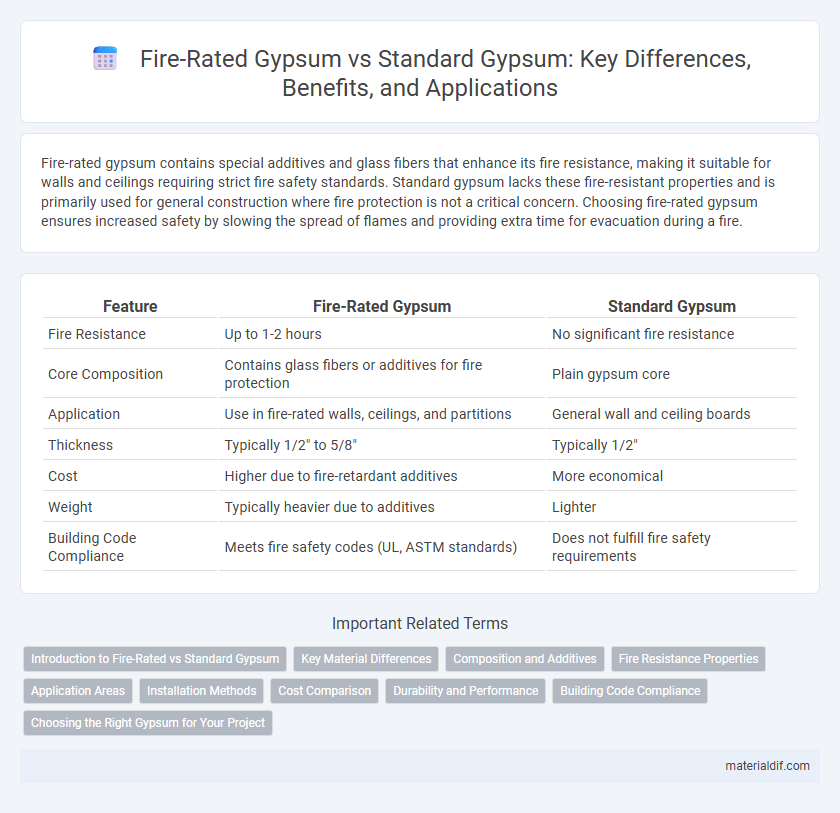Fire-rated gypsum contains special additives and glass fibers that enhance its fire resistance, making it suitable for walls and ceilings requiring strict fire safety standards. Standard gypsum lacks these fire-resistant properties and is primarily used for general construction where fire protection is not a critical concern. Choosing fire-rated gypsum ensures increased safety by slowing the spread of flames and providing extra time for evacuation during a fire.
Table of Comparison
| Feature | Fire-Rated Gypsum | Standard Gypsum |
|---|---|---|
| Fire Resistance | Up to 1-2 hours | No significant fire resistance |
| Core Composition | Contains glass fibers or additives for fire protection | Plain gypsum core |
| Application | Use in fire-rated walls, ceilings, and partitions | General wall and ceiling boards |
| Thickness | Typically 1/2" to 5/8" | Typically 1/2" |
| Cost | Higher due to fire-retardant additives | More economical |
| Weight | Typically heavier due to additives | Lighter |
| Building Code Compliance | Meets fire safety codes (UL, ASTM standards) | Does not fulfill fire safety requirements |
Introduction to Fire-Rated vs Standard Gypsum
Fire-rated gypsum contains special additives and glass fibers that enhance its fire resistance, allowing it to withstand high temperatures and prevent the spread of flames in building applications. Standard gypsum lacks these fire-retardant qualities and is primarily used for general wall and ceiling construction where fire resistance is not required. Fire-rated gypsum boards meet stringent building codes and safety standards for fire protection in residential and commercial structures.
Key Material Differences
Fire-rated gypsum contains non-combustible additives such as glass fibers and special binders that enhance its resistance to high temperatures and prevent structural failure during fires. Standard gypsum primarily consists of calcium sulfate dihydrate with limited fire resistance, making it more suitable for everyday interior applications where fire protection is not critical. The core difference lies in the fire-rated gypsum's ability to maintain integrity and insulation under fire exposure, unlike standard gypsum which softens and collapses more quickly.
Composition and Additives
Fire-rated gypsum contains additional additives such as glass fibers and vermiculite that enhance its fire resistance by improving thermal insulation and structural integrity under high temperatures. Standard gypsum primarily consists of calcium sulfate dihydrate with fewer additives, offering basic fire resistance suitable for general applications. The incorporation of fire-retardant chemicals and reinforcing fibers in fire-rated gypsum significantly delays heat transfer and reduces smoke development during fire exposure.
Fire Resistance Properties
Fire-rated gypsum contains specialized additives and glass fibers that enhance its fire resistance, enabling it to withstand temperatures up to 1800degF (982degC) for extended periods. In contrast, standard gypsum primarily offers basic fire resistance due to its inherent water content but lacks the reinforced structure necessary for prolonged exposure. This makes fire-rated gypsum essential in building assemblies requiring fire codes compliance and increased safety measures.
Application Areas
Fire-rated gypsum is primarily used in commercial buildings, schools, hospitals, and industrial facilities where enhanced fire resistance is required by building codes to protect structural integrity and safety. Standard gypsum is commonly applied in residential construction, interior walls, ceilings, and non-load-bearing partitions where fire resistance is not a critical concern. Fire-rated gypsum often incorporates glass fibers and special additives, making it ideal for use in fire barriers, firewalls, and areas with strict fire-rating requirements, while standard gypsum suits general interior finishing needs.
Installation Methods
Fire-rated gypsum boards require precise installation techniques, including sealing joints with fire-resistant compounds and overlapping fasteners to prevent fire penetration, ensuring compliance with building codes for enhanced safety. Standard gypsum installation focuses on basic fastener spacing and joint treatment without additional fireproofing measures. Proper handling of fire-rated gypsum involves using specialized tapes and sealants designed to maintain the integrity of fire barriers during high-temperature exposure.
Cost Comparison
Fire-rated gypsum boards typically cost 20% to 30% more than standard gypsum due to added materials like glass fibers and special additives that enhance fire resistance. While initial expenses are higher, fire-rated gypsum can reduce potential fire damage costs and insurance premiums in commercial and residential buildings. Standard gypsum remains a more economical choice for non-fire-sensitive applications but lacks the protective benefits needed for compliance with fire safety codes.
Durability and Performance
Fire-rated gypsum offers enhanced durability and performance compared to standard gypsum due to its formulation with additives like glass fibers and fire-resistant core materials that improve its ability to withstand high temperatures and structural stress. Standard gypsum panels primarily provide basic fire resistance and soundproofing but lack the reinforced properties needed for prolonged fire exposure or impact resistance. Fire-rated gypsum is commonly used in building codes for safety-critical applications, ensuring compliance with fire safety standards while maintaining structural integrity.
Building Code Compliance
Fire-rated gypsum boards comply with stringent building codes by incorporating glass fibers and special additives that enhance fire resistance, meeting ASTM E119 and UL 263 standards. Standard gypsum lacks these fire-retardant properties, making it unsuitable for applications requiring fire barriers or rated assemblies. Choosing fire-rated gypsum ensures adherence to national and international fire safety regulations, crucial for occupant protection and legal compliance in construction projects.
Choosing the Right Gypsum for Your Project
Fire-rated gypsum contains special additives and a glass mat facing that provide enhanced resistance to heat and fire, making it ideal for use in areas requiring compliance with fire safety codes. Standard gypsum, while suitable for general construction and interior walls, lacks these fire-resistive properties and is best applied in non-load-bearing partitions or ceilings where fire protection is not a primary concern. Selecting the right gypsum depends on project requirements for fire safety ratings, building codes, and the environmental conditions of the installation site.
Fire-rated gypsum vs Standard gypsum Infographic

 materialdif.com
materialdif.com